Inferring normality from noised samples: Enhanced deep autoencoder with image denoising for anomaly detection
IF 6.8
1区 计算机科学
0 COMPUTER SCIENCE, INFORMATION SYSTEMS
引用次数: 0
Abstract
The goal of image anomaly detection is to detect and localize the patterns that do not meet the normal expectations in an image. The widely used reconstruction-based method typically trains an autoencoder just with normal images and detects abnormal images based on the reconstruction error. It is expected that abnormal images cannot be reconstructed well because they are not included in the training process. However, due to its strong generalization ability, the autoencoder often reconstruct abnormal images quite well, thus reducing the performance of anomaly detection. To address this problem, this paper proposes a novel anomaly detection method based on image reconstruction and image denoising. Specifically, this method enhances the autoencoder to learn robust normality by adding noise to the input images. Besides, we proposed a metric to guide the model training based on the spatial scale of abnormal regions. The experimental results demonstrate that our method achieves competitive performance comparing to the state-of-the-art methods. Moreover, based on its concise architecture, our method achieves high efficiency.
从噪声样本中推断正态性:用于异常检测的增强深度自编码器与图像去噪
图像异常检测的目标是检测和定位图像中不符合正常预期的模式。目前广泛使用的基于重建的方法通常是仅用正常图像训练自编码器,并根据重建误差检测异常图像。由于训练过程中没有包含异常图像,因此无法很好地重建异常图像。然而,由于自编码器泛化能力强,通常会对异常图像进行较好的重构,从而降低了异常检测的性能。针对这一问题,本文提出了一种基于图像重构和图像去噪的异常检测方法。具体来说,该方法通过在输入图像中加入噪声来增强自编码器学习鲁棒正态性的能力。此外,我们提出了一个基于异常区域空间尺度的度量来指导模型的训练。实验结果表明,与现有的方法相比,我们的方法具有较好的性能。此外,基于其简洁的结构,我们的方法达到了很高的效率。
本文章由计算机程序翻译,如有差异,请以英文原文为准。
求助全文
约1分钟内获得全文
求助全文
来源期刊

Information Sciences
工程技术-计算机:信息系统
CiteScore
14.00
自引率
17.30%
发文量
1322
审稿时长
10.4 months
期刊介绍:
Informatics and Computer Science Intelligent Systems Applications is an esteemed international journal that focuses on publishing original and creative research findings in the field of information sciences. We also feature a limited number of timely tutorial and surveying contributions.
Our journal aims to cater to a diverse audience, including researchers, developers, managers, strategic planners, graduate students, and anyone interested in staying up-to-date with cutting-edge research in information science, knowledge engineering, and intelligent systems. While readers are expected to share a common interest in information science, they come from varying backgrounds such as engineering, mathematics, statistics, physics, computer science, cell biology, molecular biology, management science, cognitive science, neurobiology, behavioral sciences, and biochemistry.
 求助内容:
求助内容: 应助结果提醒方式:
应助结果提醒方式:


